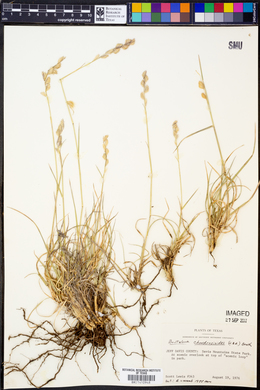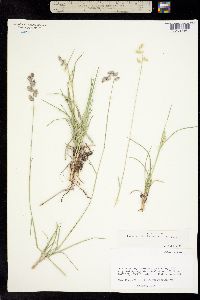Bouteloua chondrosioides
|
|
|
|
Family: Poaceae
Spruce-Top Grama, more...sprucetop grama (es: navajita morada)
[Atheropogon chondrosiodes (Kunth) Roem. & Schult., moreBouteloua havardii Vasey ex S. Watson, Bouteloua ovata Lag., Chondrosum humboldtianum Kunth, Dinebra chondrosioides Kunth] |
Plants perennial; cespitose, without rhizomes or stolons. Culms (10)30-60 cm, erect, unbranched. Leaves mostly basal; sheaths mostly glabrous, margins often long-ciliate distally; ligules 0.3-0.6 mm, of hairs; blades 1-10 cm long, 1-2.5(3) mm wide, flat, glaucous, bases with papillose-based hairs on the margins, similar hairs sometimes present on either or both surfaces. Panicles 2.5-6 cm, with 3-8(10) branches; branches (8)10-15 mm, densely pubescent, with 8-12 spikelets, axes extending to 5 mm beyond the base of the terminal spikelets, apices entire; disarticulation at the base of the branches. Spikelets appressed, all alike, 7-7.5 mm, with 1 bisexual and 1 rudimentary floret. Glumes evidently hairy; lower glumes 2.5-4.5 mm; upper glumes 4.5-6.5 mm; lowest lemmas 4.7-6.2 mm, hairy distally, 3-lobed, lobes unawned or shortly awned; lowest paleas 5-7.2 mm, pubescent along the veins and on the margins, bifid, veins excurrent as short awns; anthers 2.8-4 mm, yellow; upper florets rudimentary, glabrous, 3-awned, awns scabrous, sometimes arising from a short but evident awn column, central awns sometimes with a membranous margin, awns scabrous. Caryopses about 2.5 mm long, about 0.9 mm wide. 2n = 20, 22, 40. Bouteloua chondrosoides grows on dry, rocky slopes and grassy plateaus at 200-2500 m. Its range extends from southern Arizona and western Texas to Costa Rica. It resembles B. eludens in having pubescent panicle branches, but B. eludens usually has 12-16 branches 5-11 mm long with 2-6 spikelets whereas B. chrondrosoides usually has 3-8 branches 10-15 mm long with 8-12 spikelets per branch. Dr. David Bogler, USDA NRCS PLANTS Database Perennials, Terrestrial, not aquatic, Stems nodes swollen or brittle, Stems erect or ascending, Stems caespitose, tufted, or clustered, Stems terete, round in cross section, or polygonal, Stem internodes hollow, Stems with inflorescence less than 1 m tall, Stems, culms, or scapes exceeding basal leaves, Leaves mostly basal, below middle of stem, Leaves conspicuously 2-ranked, distichous, Leaves sheathing at base, Leaf sheath mostly open, or loose, Leaf sheath smooth, glabrous, Leaf sheath hairy at summit, throat, or collar, Leaf sheath and blade differentiated, Leaf blades linear, Leaf blades very narrow or filiform, less than 2 mm wide, Leaf blades mostly flat, Leaf blades more or less hairy, Leaf blades glaucous, blue-green, or grey, or with white glands, Ligule present, Ligule a fringe of hairs, Inflorescence terminal, Inflorescence with 2 or more spikes, fascicles, glomerules, heads, or clusters per culm, Inflorescence a panicle with narrowly racemose or spicate branches, Inflorescence with 2-10 branches, Inflorescence branches 1-sided, Flowers bisexual, Spikelets sessile or subsessile, Spikelets laterally compressed, Spikelet less than 3 mm wide, Spikelets with 1 fertile floret, Spikelets solitary at rachis nodes, Spikelets all alike and fertille, Spikelets bisexual, Inflorescence branches deciduous, falling intact, Spikelets secund, in rows on one side of rachis, Rachilla or pedicel glabrous, Glumes present, empty bracts, Glumes 2 clearly present, Glumes equal or subequal, Glumes equal to or longer than adjacent lemma, Glume equal to or longer than spikelet, Glume surface hairy, villous or pilose, Glumes 1 nerved, Lemma coriaceous, firmer or thicker in texture than the glumes, Lemma 3 nerved, Lemma glabrous, Lemma body or surfac e hairy, Lemma apex dentate, 3-5 fid, Lemma awnless, Lemma margins thin, lying flat, Lemma straight, Palea present, well developed, Palea membranous, hyaline, Palea shorter than lemma, Palea 2 nerved or 2 keeled, Stamens 3, Styles 2-fid, deeply 2-branched, Stigmas 2, Fruit - caryopsis, Caryopsis ellipsoid, longitudinally grooved, hilum long FNA 2003 Common Name: sprucetop grama Duration: Perennial Nativity: Native Lifeform: Graminoid General: Tufted perennial grass, stems firm and hard at the base but not rhizomatous, 30-60 cm tall. Vegetative: Sheaths rounded, mostly glabrous, margins often long-ciliate distally; ligules hairy, 0.5 mm; blades glaucous, short, flat, 1-3 mm broad, 1-10 cm long, mostly in a basal clump, not curled, bases with papillose-based hairs on the margins. Inflorescence: Panicle consists of three to seven pectintate spicate branches, each 1 to 1.5 cm long, these borne on the upper 2-6 cm of the stem axis; spicate branches with a flattened, densely hairy rachis and 8-12 closely placed spikelets, deciduous as a whole; all exposed structures of the spikelets more or less hairy; each spikelet with 2 florets, the floret bisexual and the upper floret rudimnetary; fertile lemma three-cleft, the divisions with short awns; rudiment large, the lemma 3-awned, the middle awn broadly winged below. Ecology: Found on dry rocky slopes and rolling desert grassland with fine-textured soils from 2,500-6,000 ft (762-1829 m); flowers August-October. Distribution: se AZ to w TX and south to Costa Rica. Notes: This species is a part of a group of Bouteloua very similar in appearance being perennials with short inflorescence branches (sometimes appearing as clusters of spikelets) on both sides of the axis which are deciduous as a whole, the branches completely falling off and leaving a small nodule behind. Distinguished from the similar B. repens by having pubescence on all surfaces of the spikelets and 3-7 spicate branches (7 - 12 in repens), from B. eludens by having shorter panicles 3-6 cm long (6-10 cm in eludens) and branches with 8-12 spikelets (2 - 6 in eludens) and from B. radicosa by lacking a hard, knotty, rhizomotous base. Ethnobotany: Unknown, but other species in the genus have uses. Etymology: Bouteloua named for brothers Claudio (1774-1842) and Esteban (1776-1813) Boutelou Agraz, Spanish botanists and horticulturalists; chondrosioides means like the genus Chondrosium. Synonyms: Chondrosum humboldtianum, Dinebra chondrosioides Editor: SBuckley 2010, FSCoburn 2014, AHazelton 2015 |
|
|
|






























































































